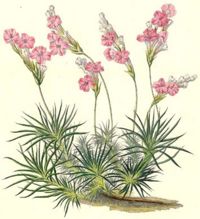Acantholimon
| Acantholimon subsp. var. | Prickly thrift | |||||||||||||||||||||||||||||||||||||||||||||||||||||||
|---|---|---|---|---|---|---|---|---|---|---|---|---|---|---|---|---|---|---|---|---|---|---|---|---|---|---|---|---|---|---|---|---|---|---|---|---|---|---|---|---|---|---|---|---|---|---|---|---|---|---|---|---|---|---|---|---|

|
|
| ||||||||||||||||||||||||||||||||||||||||||||||||||||||
| ||||||||||||||||||||||||||||||||||||||||||||||||||||||||
Acantholimon (Prickly thrift) is a genus of small flowering plants within the plumbago or leadwort family, Plumbaginaceae. They are distributed from southeastern Europe to central Asia and also in South America, but also cultivated elsewhere in rock gardens.
| Standard Cyclopedia of Horticulture |
|---|
|
Acantholimon (akanthos, spine, and limon, sea lavender). Syn., Armeriastrum. Plumbaginaceae. Prickly Thrift. Hardy evergreen perennials, sometimes a little woody. Leaves stiff, linear, round or slightly 3-angled, the angles channeled, the apex nearly always sharp- pointed: scape and peduncle nearly always simple, sometimes a little branched: fls. usually between and half hidden by the numerous bracts of the tightly compressed heads, spikes or racemes; corolla rose or white, the petals at the base united to form a ring around the stamens; calyx tubular, the tube 10-ribbed. Boissier describes 74 species in the Flora Orientalis. See A. Bunge, Die Gattung Acantholimon, St. Petersburg, 1872. The acantholimons are dwarf, tufted herbs, with sharp-pointed, rigid leaves; less common than Statice and Armeria, from both of which it is distinguished by its sharp-pointed leaves. An oriental genus of slow-growing and sun-loving plants for rockeries and sandy places. Most of them can be grown in the open border, A. glumaceum particularly, but they prefer warm, sunny situations in the rock-garden. Propagation is best effected by cuttings taken in late summer and kept in a coldframe, protected from the frost, over winter. Layering is also a quicker method of propagation.CH
|
Cultivation
- Do you have cultivation info on this plant? Edit this section!
Propagation
- Do you have propagation info on this plant? Edit this section!
Pests and diseases
- Do you have pest and disease info on this plant? Edit this section!
Species
Species of Armeria includewp: Species of Acantholimon include:
- Acantholimon albertii
- Acantholimon avenaceum
- Acantholimon glumaceum
- Acantholimon göksunicum
- Acantholimon hohenackeri
- Acantholimon köycegizicum
- Acantholimon venustum
Gallery
If you have a photo of this plant, please upload it! Plus, there may be other photos available for you to add.
-
photo 1
-
photo 2
-
photo 3
References
- Standard Cyclopedia of Horticulture, by L. H. Bailey, MacMillan Co., 1963
External links
- w:Acantholimon. Some of the material on this page may be from Wikipedia, under the Creative Commons license.
- Acantholimon QR Code (Size 50, 100, 200, 500)
